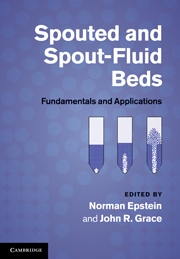Book contents
- Frontmatter
- Contents
- Contributors
- Preface
- Common nomenclature
- 1 Introduction
- 2 Initiation of spouting
- 3 Empirical and analytical hydrodynamics
- 4 Computational fluid dynamic modeling of spouted beds
- 5 Conical spouted beds
- 6 Hydrodynamics of spout-fluid beds
- 7 Spouted and spout-fluid beds with draft tubes
- 8 Particle mixing and segregation
- 9 Heat and mass transfer
- 10 Powder–particle spouted beds
- 11 Drying of particulate solids
- 12 Drying of solutions, slurries, and pastes
- 13 Granulation and particle coating
- 14 The Wurster coater
- 15 Gasification, pyrolysis, and combustion
- 16 Spouted bed electrochemical reactors
- 17 Scaleup, slot-rectangular, and multiple spouting
- 18 Mechanical spouting
- 19 Catalytic reactors and their modeling
- 20 Liquid and liquid–gas spouting of solids
- Index
- References
16 - Spouted bed electrochemical reactors
Published online by Cambridge University Press: 04 February 2011
- Frontmatter
- Contents
- Contributors
- Preface
- Common nomenclature
- 1 Introduction
- 2 Initiation of spouting
- 3 Empirical and analytical hydrodynamics
- 4 Computational fluid dynamic modeling of spouted beds
- 5 Conical spouted beds
- 6 Hydrodynamics of spout-fluid beds
- 7 Spouted and spout-fluid beds with draft tubes
- 8 Particle mixing and segregation
- 9 Heat and mass transfer
- 10 Powder–particle spouted beds
- 11 Drying of particulate solids
- 12 Drying of solutions, slurries, and pastes
- 13 Granulation and particle coating
- 14 The Wurster coater
- 15 Gasification, pyrolysis, and combustion
- 16 Spouted bed electrochemical reactors
- 17 Scaleup, slot-rectangular, and multiple spouting
- 18 Mechanical spouting
- 19 Catalytic reactors and their modeling
- 20 Liquid and liquid–gas spouting of solids
- Index
- References
Summary
Introduction
Electrochemical reactions are used in the chemical, metallurgical, pharmaceutical, and other industries, as such reactions typically allow precise control of reactions by adjustment of voltage. Such reactions usually carry a high capital and energy cost, however, and there has been much investigation to improve space-time yield, current efficiency, and electric power consumption.
Figure 16.1 shows schematically the geometric arrangement of several electrochemical reactors. Broadly, these designs have two electrodes separated by a liquid electrolyte, and in some instances a separator capable of ion transport. Electrochemical reactions are inherently heterogeneous, occurring at the interface between an electronic and an ionic conductor; mass transport of ions to and from such interfaces therefore plays an important role. Unlike other heterogeneous reactions, such as reaction of a gas on a solid catalytic surface, transport on the other side of the interface (of charge, i.e., electrical current) is also significant. The need for this latter conduction motivates many aspects of design in Figure 16.1, as discussed in this chapter. An important parameter of the designs in Figure 16.1 is the electrode surface area per unit of reactor volume; the higher this value, the higher the space-time yield, other things being equal. Moving along the top row and down to the bottom row should provide designs in which space-time yields are high and perhaps designs in which high mass transfer rates can be exploited as well.
- Type
- Chapter
- Information
- Spouted and Spout-Fluid BedsFundamentals and Applications, pp. 269 - 282Publisher: Cambridge University PressPrint publication year: 2010



